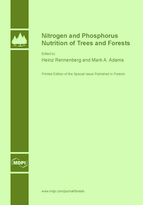Nitrogen and Phosphorus Nutrition of Trees and Forests
A special issue of Forests (ISSN 1999-4907).
Deadline for manuscript submissions: closed (30 June 2015) | Viewed by 92541
Special Issue Editors
Interests: nitrogen and phosphorus nutrition; nitrogen and sulfur metabolism; abiotic and biotic stress physiology; biogenic emissions; phytoremediation
Special Issues, Collections and Topics in MDPI journals
Special Issue Information
Dear Colleagues,
Nitrogen (N) and phosphorus (P) nutrition of trees has been studied for many decades, but has largely been focused on inorganic nutrient uptake and leaf level nutrient contents. In recent years it became obvious that N and P cycling at the ecosystem level is of vital importance for tree nutrition and that organic N uptake by trees is an essential part of ecosystem N cycling; in particular on N and/or P poor soils, and in cooler climates. The significance of organic P uptake by trees is still a matter of debate, especially under field conditions. The overlay of climate change on ecosystem N and P cycling has become an important issue of forest research. This overlay raises questions around competition for N and P among structural elements (overstorey vs. undestorey), as well as among dominant species. Many nutritionally related aspects of changing climates, such as effects on rhizosphere and phyllosphere, remain seriously under-studied. The central aim of this Special Issue is to provide new insights into some of these topics at the tree, and the ecosystem level.
Prof. Dr. Heinz Rennenberg
Prof. Dr. Mark A. Adams
Guest Editor
Manuscript Submission Information
Manuscripts should be submitted online at www.mdpi.com by registering and logging in to this website. Once you are registered, click here to go to the submission form. Manuscripts can be submitted until the deadline. All submissions that pass pre-check are peer-reviewed. Accepted papers will be published continuously in the journal (as soon as accepted) and will be listed together on the special issue website. Research articles, review articles as well as short communications are invited. For planned papers, a title and short abstract (about 100 words) can be sent to the Editorial Office for announcement on this website.
Submitted manuscripts should not have been published previously, nor be under consideration for publication elsewhere (except conference proceedings papers). All manuscripts are thoroughly refereed through a single-blind peer-review process. A guide for authors and other relevant information for submission of manuscripts is available on the Instructions for Authors page. Forests is an international peer-reviewed open access monthly journal published by MDPI.
Please visit the Instructions for Authors page before submitting a manuscript. The Article Processing Charge (APC) for publication in this open access journal is 2600 CHF (Swiss Francs). Submitted papers should be well formatted and use good English. Authors may use MDPI's English editing service prior to publication or during author revisions.
Keywords
- N uptake
- P uptake
- inorganic N
- organic N
- inorganic P
- organic P
- ecosystem N cycling
- ecosystem P cycling
- plant–microbial interactions
- biosphere–atmosphere–hydrosphere exchange







